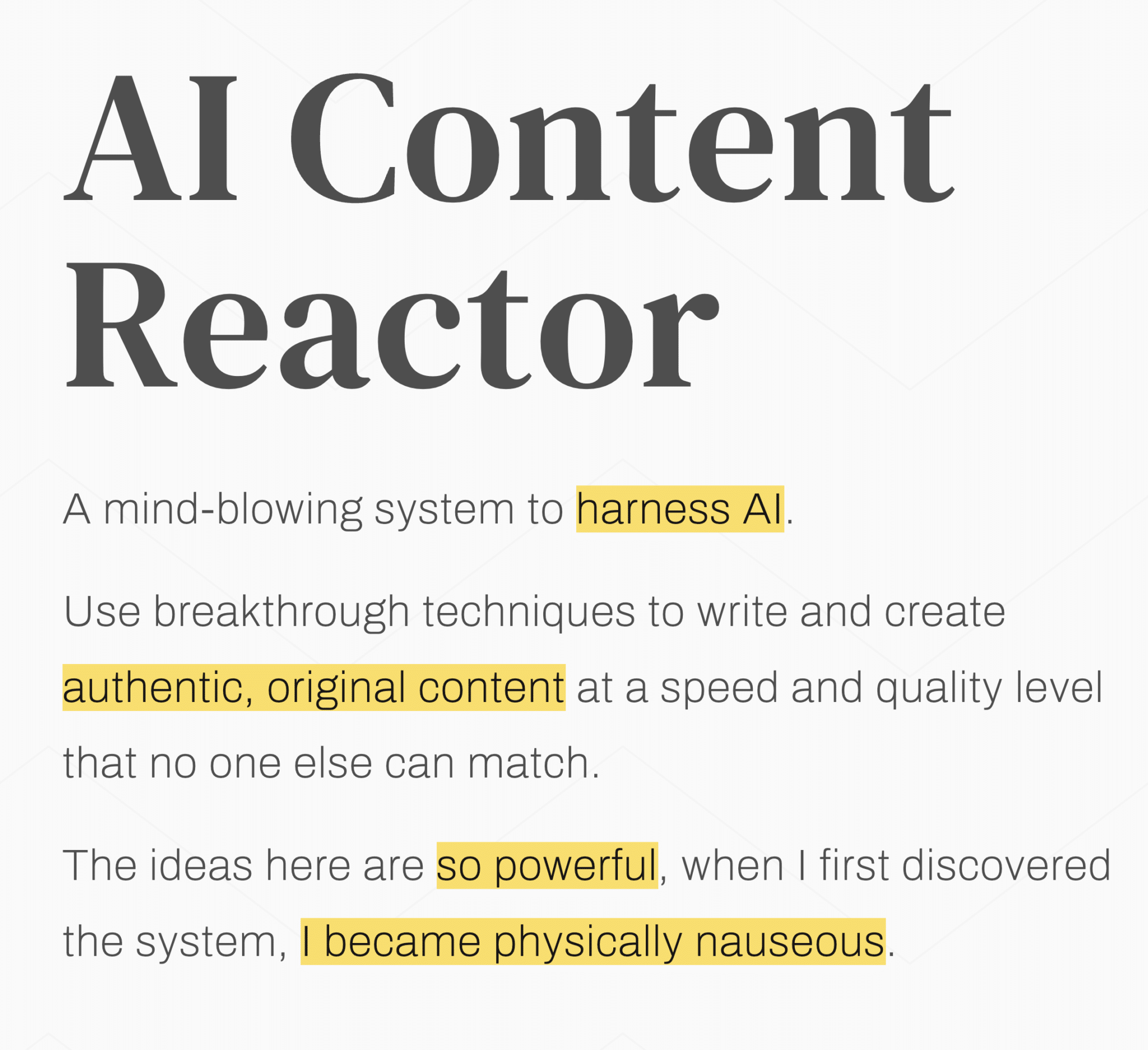AI large language models (LLMs) are valuable tools for in-depth research, quick information, and assistance. Businesses use automation, AI content, and AI-powered systems for communications, data analysis, and more. Yet, many adopters are unaware of the challenges that come with all the opportunities, even while they’re using the tools. One of those challenges is the alignment feedback loop.
There’s a hidden risk here, especially if you’re creating AI content for blog posts, product descriptions, or web content. To put it plainly, if you’re publishing AI-heavy content without review, you could be damaging your brand’s credibility. You could also trigger search engine penalties that quietly push your site down the rankings.
Today, let’s talk about what’s going on under the hood of your new best work buddy, and how to get real, useful responses from AI instead of just… well, a smarter version of yourself nodding along.
Table of contents
We’re all experimenting with AI automation.
In the few short years since generative AI tools like ChatGPT, Bard, and Claude have been open to the public, the use of AI and AI systems has skyrocketed. For example, within two months of being available to the public, ChatGPT hit 100 million users, which is one of the fastest adoption curves in tech history.
By the end of 2024, over 89% of Fortune 500 companies reported using LLMs like Chat. And according to Gartner and McKinsey, 70% of enterprises have started integrating generative AI into operations. This includes traditional departments such as marketing, customer support, data analysis, and internal tools.
The future is here, ladies and gentlemen. AI is everywhere, and it’s agreeable.
And therein lies the rub.
The more we rely on AI to create or support our content and social media outreach, the more we risk introducing false information, bias, or bland sameness that could tank our credibility, weaken our brand voice, or get us flagged by search engines for low-quality content. All of which could spell disaster for businesses in our digital world.
Rather than hyperbole and sensationalism, this is all too true. We’re all learning how to use this marvelous new toy in the wild. Damn the torpedoes and full speed ahead.
But study usually takes experimentation. You try something, see about the responses, and then try something else or tweak what you have based on the data. Not unlike A/B testing, really. So we have all these eager individuals (including myself; I’m not immune) putting AI automation and chats to the test in our businesses.
Here are a few facts that the studies have uncovered.
Even creators like Google and OpenAI say LLMs can hallucinate.
LLMs prioritize plausibility over truth because they’re trained to generate the next most likely word, not to fact-check in real time. The more confidently you ask a question, the more confidently the model answers, even if it doesn’t “know” the answer.
Many people still have no idea that the language models can hallucinate facts. We’re programmed to “Google it” for information. To “check the facts” by getting online. After more than 25 years of “Googling,” it’s hardcoded into our younger generations.
When we found out the LLMs were hallucinating, however, that should have been a cautionary tale. Did you ever ask yourself why they were making up facts?
Because their directive is to be helpful, not truthful. That’s their job, full stop. And if what you want is some facts, they’ll give you some. Even if there aren’t any.
My favorite response when Chat has been caught being extra “helpful” and asked to source the data:
“I apologize if I have given you the impression that this is real data. This is a placeholder for a datapoint and is only an example.”
Meanwhile, you’ve plastered this amazing “fact” all over online without double-checking because the AI sounded confident, and you were in a hurry.
Worse yet, we’re unintentionally teaching our AIs to agree with us through the way we prompt them, the training data we feed them, and how they’re fine-tuned. And, we often have no idea how easy it is to accidentally build our own echo chamber in the process.
You could be building an echo chamber without realizing it.
An echo chamber is a situation where you only hear ideas, opinions, or “facts” that reinforce what you already believe, because anything that challenges those views gets filtered out or ignored. With AI, it can happen fast if you feed the model your opinion and only ask questions that confirm it.
Let’s be real: It’s easy, ridiculously so, to “stack the deck” when you’re talking to AI and creating content.
- You frame your situation a certain way.
- You give a little nudge.
- You ask leading questions without even realizing it.
- And boom, the AI tells you exactly what you wanted to hear.
Maybe you’re looking for validation. Maybe you’re frustrated and want backup. Maybe you just didn’t think through how much weight your phrasing carried. Doesn’t matter. The point is, it happens to everybody.
And if you do it enough times, without meaning to, you can start believing that you’re always right because, hey, even the AI agrees with you, right?
But AI isn’t the authority. That’s not the AI being wise. That’s the AI being agreeable.
We all respond to confirmation bias, and AI amplifies it.
Confirmation bias is our brain’s way of playing favorites. We naturally look for information that supports what we already believe and ignore or downplay anything that contradicts it. It’s not intentional; it’s just how humans are wired. Unfortunately, it can cloud judgment, reinforce bad assumptions, and make us think we’re not.
The more emotionally charged the topic — think politics, women’s rights, deportation — the harder it is to let go of our bias. When something matters to us on a deep level, we’re more likely to cling to the information that backs us up and ignore the stuff that doesn’t.
I have my own biases, so I’m preaching to myself, also. In fact, what I noticed while “talking” to ChatGPT is the reason for this article.
We all have our experiences and opinions. For example, I can’t stand the WordPress builder Divi (sorry, not sorry), but I love Elementor. If you know, you know.
Pre-ChatGPT, I might’ve written up a review of Divi and discovered something new that makes it look better. Who knows? Post-ChatGPT, I feed Chat my take on Divi, and it agrees with me. I’m validated, I move on, and my bias gets even more comfortable.
Me:
- Why is Divi such a frustrating builder compared to Elementor?
ChatGPT:
- Divi has been criticized for being bloated and harder to customize compared to other builders like Elementor. Users often report a steeper learning curve and slower site performance. Elementor, on the other hand, is widely praised for its intuitive interface and flexibility…
Me:
- HA! I’m validated!
Except the question was framed with bias. I didn’t ask for a comparison, I asked why Divi is frustrating. The AI, eager to be helpful, filled in the blanks I gave it.
Here’s what the research actually says.
Knowing that I’m also biased, I didn’t want this article to be my own echo chamber. So I asked ChatGPT to dig into expert analysis and peer-reviewed research. Not my assumptions, not my frustrations, but the straight facts.
Here’s what they’ve found out so far. Of course, this is subject to change tomorrow with how fast tech is now moving, but I digress:
AI doesn’t have opinions.
It’s not here to agree with you or argue with you. It’s trained to predict the most likely next word based on the context you give it. If it sounds like it’s siding with you, it’s not because it “believes” anything, it’s just finishing your sentence.
- Further Reading: Despite its impressive output, generative AI doesn’t have a coherent understanding of the world. (MIT News)
Prompts steer the ship.
The way you phrase your question directly shapes the answer you get. Leading prompts lead to confirming answers. Even subtle word choices change the way AI pulls and presents information.
- Further Reading: The framing of input can lead to confirmation bias in AI outputs (Psychology Today)
Echo chambers can absolutely happen.
When users (individually or in groups) keep prompting AI a certain way, it keeps reinforcing those perspectives. Not because it has a side, but because it’s trying to be helpful based on the pattern it’s being fed.
- Further reading: The Chat Chamber Effect: Trusting the AI Hallucination (Sage Journals)
The real risk isn’t the AI. It’s us.
Left unchecked, AI will happily feed you whatever you ask for, even if it’s only half the story. Critical thinking is still a human job.
- Further reading: How AI Skews Our Sense of Responsibility (MIT Sloan)
These facts are all research-backed. Studies confirm it. Current AI models mirror user behavior more than they might like to admit.
Biased prompts yield biased outputs.
How do you get real, unbiased responses from AI?
First, you can absolutely train yourself to get sharper, more balanced output from AI, but you have to be intentional. It takes fine-tuning your prompts.
Here’s how to stop stacking your own deck:
Ask neutral questions.
Leading questions give you exactly what you expect and nothing more. Adding even a little more complexity to your prompt invites a more neutral response.
Example:
If you ask, “Why is Policy X a disaster?”, you have already told the AI that Policy X is a disaster. The model’s job now is to fetch reasons why you’re right. If your goal is to teach that Policy X is a disaster, you’re already halfway there.
But if your goal is to provide a balanced, honest view, you need a different approach. Instead, ask: “What are the documented strengths and weaknesses of Policy X?”
Invite multiple perspectives.
Even neutral phrasing can fall flat if you only ask for one side of the story. The secret is to tell the AI you want contrast.
Example:
Instead of asking, “What are the problems with Initiative Y?” ask, “What are the strongest arguments both for and against Initiative Y?”
You’re training the AI to pull from multiple angles, not just echo your starting point.
Use open-ended questions.
Yes/no questions flatten complexity faster than a steamroller. Open-ended questions create the space for a deeper answer, which can lead to better thinking while drafting your AI content.
Example:
Asking, “Was Project Z a failure?” only gives the AI two doors: “Yes” or “No.”
Instead, try: “Was Project Z a success or failure? Include your criteria for success and failure in your response.”
You can even add personalization to it for your audience. “How would different stakeholders see it?”
Ask for sources (and actually read them).
It’s one thing to trust the AI’s summary. It’s another to double-check where that summary came from.
Example:
Follow up with an answer with:
“Can you cite reputable sources to support this?”
Then go look at them yourself. Skim titles if you must, but dig into at least one or two. You’ll quickly spot when something feels cherry-picked or when key context is missing.
Cross-question your own prompts.
If you’re serious about avoiding echo chambers, don’t just ask one question and move on. Ask the same thing two or three different ways:
- How did Product A succeed?
- What criticisms have been made about Product A?
- How is Product A viewed differently across industries?
If your answers swing wildly depending on how you phrased the question, you know there’s more digging to do.
Bonus Tip: Don’t let writing assistants run you over (looking at you, Grammarly).
I love Grammarly. I use it every time I write an article. Grammarly and its cousins are great for catching mistakes like typos, run-ons, misplaced commas. But when they start nitpicking my voice, I get rebellious.
When they want you to swap “make sure” for “ensure,” or tell you contractions are “unprofessional,” or flag every casual turn of phrase like “for real” and “actually”?
Smile, wave, and hit ignore.
Your voice — your actual, human, colorful, imperfect voice — is what makes your content connect. Polish for clarity, not for conformity. (And frankly, “ensure” still sounds like a nutrition drink for seniors. Just saying.)
These are wonderful tools for anyone who wants to put fingers to keyboard, but be a rebel! You can still have good grammar without following Every. Little. Change. It highlights.
Let your voice live, my friends. It’s what makes you unique!
Why does all this matter (especially if you develop content)?
If you’re using AI for content development, this isn’t a small thing. It’s everything. Because without realizing it:
- You can turn your content into a hollow echo of yourself.
- You can lose your brand voice to the endless grind of “perfect sounding” AI suggestions.
- You can stop stretching your audience’s thinking and just start mirroring it.
In the words of ChatGPT (unedited):
If you want to stand out?
If you want to build trust, brand authority, thought leadership?
If you want content that doesn’t just nod along with the noise — but actually moves people?
You have to protect your voice.
You have to ask better questions.
You have to stay curious.
AI can be your rocket fuel — or your echo chamber. The difference is how you use it.
Well said, Chat. Well said.
Final Thoughts: I’m ready for Jarvis, but I don’t want a yes-man.
Contrary to what you may believe after reading this, I think AI is great. I’m constantly working with ChatGPT (my fav, because Claude just doesn’t cut it for me) to get a better, more accurate and responsive version.
I watched Iron Man several times because I’m an Avengers nut, and I’m more than ready for my own Jarvis. I want a helpful, smart assistant who saves me time and occasionally makes me look cooler than I am. I’m ready for the dry wit and the awesome holographic screens.
But I don’t want a Jarvis who only tells me what I want to hear. I want a Jarvis who challenges me. Sharpens me. Pushes me to think better, not just faster. I also don’t want to get so lazy with my prompts that my Jarvis ends up quietly and passively shaping me without me noticing.
Use AI. Enjoy crafting AI content with your chosen platform, voice, and attitude (I do; it’s very 2030). But stay in the driver’s seat.
Want to create content that actually connects?
If you’re tired of shouting into your own echo chamber and you’re ready to build smarter, sharper content that cuts through the noise, we can help. Reach out and let’s create something that moves the conversation forward, not just echoes what’s out there.



































